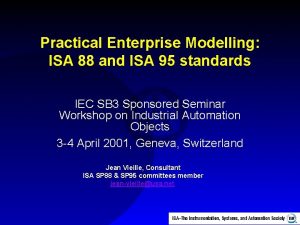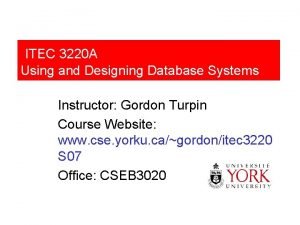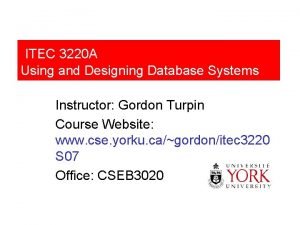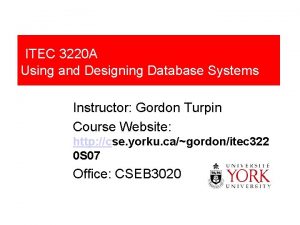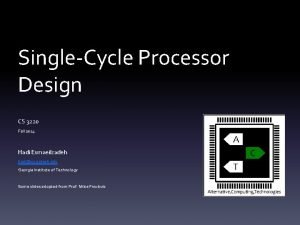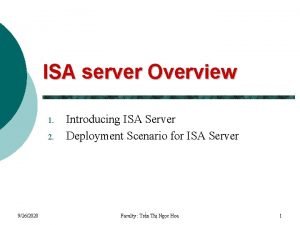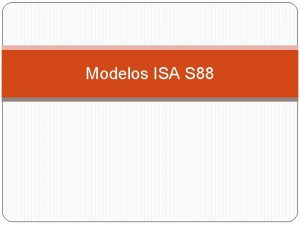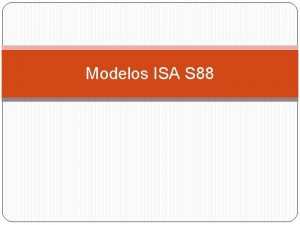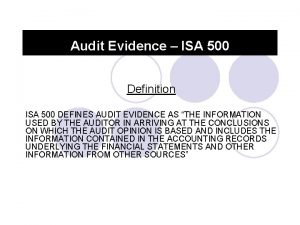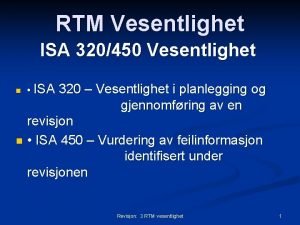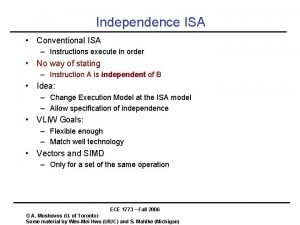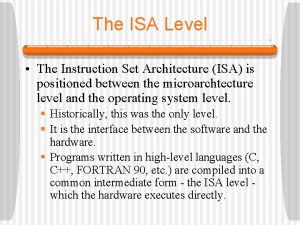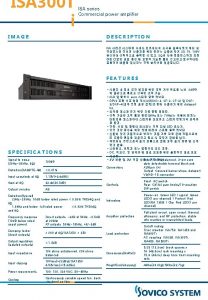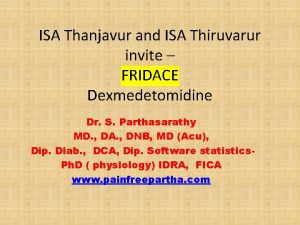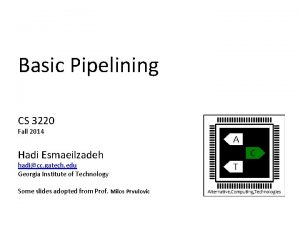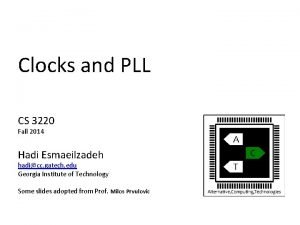ISA Design for the Project CS 3220 Fall












![Instruction Format Thus Far wire [3: 0] op 1; // Primary opcode wire [3: Instruction Format Thus Far wire [3: 0] op 1; // Primary opcode wire [3:](https://slidetodoc.com/presentation_image_h/8d90efa991e16576ddd298649b209a70/image-13.jpg)




















- Slides: 33

ISA Design for the Project CS 3220 Fall 2014 Hadi Esmaeilzadeh hadi@cc. gatech. edu Georgia Institute of Technology Some slides adopted from Prof. Milos Prvulovic

Project ISA § Who are the players? – Are we doing HW/SW co-design? § We will be designing processor, need an ISA § What do we want in our ISA – Easy to decode (you’ll have to write this in Verilog) – Easy to write assembler for (you’ll have to write one) – Easy to write applications for (you’ll do this, too) § Similar tradeoff involved in designing real CPUs – Plus backward compatibility – But for CS 3220 we don’t want backward compatibility! – Encourages laziness and cheating (Verilog code may already be posted somewhere) 2

ISA decisions § CISC or RISC? – Definitely RISC (much easier to design) § Fixed-size or variable size? – Definitely fixed (fetch and decode much easier) § How many things can be read or written – Each register read (>1) complicates register file – Each register write (>1) complicates register file a lot! – Each memory read or write (>1) creates lots of problems (memory ports, pipeline stages, hazards). 3

Which instructions? Memory! § How will we access memory – Do we use only LD/ST, or do we allow memory operands in other kinds of instructions? § Only LD/ST is far simpler to implement because: – Mem operands in ADD, SUB, etc. require many “flavors” for each instruction (tough to decode) • And we need to describe the entire decoding logic in Verilog – Don’t want multiple memory accesses per inst! • Even one memory stage in the pipeline is complex enough § OK, we’ll have LW, SW 4

Which instructions? ALU! § Let’s have some arithmetic – ADD, SUB, what else? § How about some logic? – Option 1: AND, OR, NOT, XOR, etc. – Option 2: Let’s just have one! Which one? NAND! • Can “fake” others using NAND, e. g. “NOT A” is “A NAND A” – Let’s use Option 1 but not go overboard • Easier to write assembler, easier to decode • But leave room (unused opcodes) for more § Comparisons? It depends… – Option 1: Conditional branches do comparisons – Option 2: Comparison instructions, one cond. branch – Option 3: Mix of the two 5

Speaking of branches… § Conditional branches – PC relative, need decent-sized offset operand – Hard to write if-then-else and loops if branch only goes e. g. 3 instructions forward or back § How will we call procedures? – Option 1: Special branch that saves return address – Option 2: Save RA in SW, use normal branch § How will we return from procedures? – Option 1: Specialized “RET” – Option 2: Jump-to-address-in-register (JR) § Let’s have only one call/jump/return inst for now! – Similar to JALR instruction from CS 2200 – Syntax would be JAL Rdst, Imm(Rsrc) 6

Conditional branches? § Typical conditional branches BEQ R 1, R 2, Label ; Go to Label if R 1==R 2 • Can also have BLT, BLE, BNE, BGT, BGE • Need to encode two registers in the instruction BEQZ R 1, Label ; Go to Label if R 1==0 • Can also have BNEZ, BLEZ, etc. • Need to encode only one register in the instruction (so we can have a 6 -bit offset) § Could have implicit operand, e. g. always R 1 BEQZ Label ; If R 1==0 go to Label • Bad: R 1 won’t be very useful for anything else 7

How many registers? § Need at least 2 to do ALU operations § Plus one to be a stack pointer § Plus one to save return address – Unless we want to save it directly to memory § Nice to have a few extra – One for return value (to avoid saving it to stack) – Some to pass parameters? Need at least 2 (more is even better) § Need at least one for system use – We’ll work on this in the last two projects § OK, this is already 8 or more, so let’s have 16 – When writing code in assembler, we’ll see that more is better 8

Size of instruction word? § Bits in instruction word? Hmm, let’s see – Need room for opcode • How many types of instructions do we have? • Can have a secondary opcode for some (e. g. for ADD, SUB, etc. ) – Need room for register operands • Do we want 1, 2, or 3 or those? 3! • This will use 12 bits in the instruction word – Need room for immediate operands • The more the better, but too few will be a problem § Let’s have 32 -bit instruction word – 8 not really an option (not enough room) – 16 is very tight (with 16 regs, only 4 bits left for opcode) – So let’s do 32 (allows large offsets, more opcodes, etc. ) 9

Register size? § How about 8? – Will need multi-word values often (e. g. loop counters) – PC must be larger than this, procedure calls get tricky § Can we do with 16? – Most loops and programs will be OK – Immediate operand can load entire constant (nice) – Can display entire word on HEX display § But it makes sense to have 32 -bit registers – Same as instruction word – Almost never have to worry about overflows and such 10

Memory addressing? § Byte-addressed or word-addressed? § Word-addressed is simpler – Only need LD/ST instruction, vs. LW/SW, LB/SB, etc. – Don’t have to worry about alignment § But – Hard to switch apps to byte-addressed later – Can’t use e. g. 16 -bit memory locations – We can achieve most of the HW simplicity if we require word-alignment § So we’ll have byte-addressed aligned LW/SW only – Can drop alignment limitations later if we want to – But can add LB/SB, LH/SH later if we want to 11

ISA definition § How many bits for the opcode? § For insts w/ 3 reg operands, 12 bits already used – Great, leaves 20 bits for opcode! But… § For insts w/ 2 reg and 1 imm operand – E. g. LW R 1, -4(R 2), ADDI R 1, R 2, 64, BNE R 1, R 2, Label – Imm and opcode must fit in 24 bits (10 used for regno) § Let’s have a 16 -bit immediate and 4 -bit opcode – – Will make register number decoding a bit easier Few “reach” issues in branches and LW/SW Fairly large constants in ADDI, SUBI, ANDI, etc. We have 16 opcodes • Won’t be enough – LW, SW, • Will needa a trick called “secondary opcode” to for >16 instructions 12
![Instruction Format Thus Far wire 3 0 op 1 Primary opcode wire 3 Instruction Format Thus Far wire [3: 0] op 1; // Primary opcode wire [3:](https://slidetodoc.com/presentation_image_h/8d90efa991e16576ddd298649b209a70/image-13.jpg)
Instruction Format Thus Far wire [3: 0] op 1; // Primary opcode wire [3: 0] rd, rs, rt; // Register operands wire [15: 0] imm; // 16 -bit immediate operand assign {op 1, rd, rs, rt, imm}=iword; § Decoding of register numbers is trivial § But… only 16 different instructions? – LW, SW (and leave room for LH, SH, LB, SB) – ADDI, ADD, SUB, AND, OR, XOR, NOT – BEQZ, BNEZ, JAL – This is already 16 • What if we want to add more later, e. g. MUL? 13

Primary/Secondary Opcode § Have a smaller primary opcode (our four bits) – Instructions without an imm operand have 16 “free” bits • ADD Rd, Rs, Rt uses 16 bits for primary opcode and regs – Instructions with an imm but only two regs have 4 free bits • LW Rd, Imm(Rs) does not use the Rt field – Also ADDI Rd, Rs, Imm, SUBI, etc. • SW Rt, Imm(Rs) does not use the Rd field – Also BEQ Rs, Rt, Imm, etc. § Idea: Use these extra bits for a secondary opcode – Uses only one primary opcode for a family of ALU instructions – Secondary opcode => the actual operation § Primary opcode of 0000 now means “ 3 -reg ALU inst” – Imm field unused => Secondary opcode can be up to 16 bits – We’ll use only 6 for now (enough for many insts) • E. g. 000000 is NOP, 000001 is ADD, etc. § Primary opcode of 1000 now means “ 2 -reg load inst” – Secondary opcode in Rt field (4 bits), e. g. 0000 is LW § … 14

Assign Primary Opcodes § Does it matter which insts get which opcode? – E. g. ALU Rd, Rs, Rt 0000, ALU Rd, Rs, Imm is 0001, etc. ? § Make the decoding easy! – After we read the primary opcode, need to look at secondary opcode to finish decoding – Let some opcode bits tell us where the op 2 is! § Assigning opcode numbers as a list is messy – So we use an opcode chart 15

Opcode Chart § We have 4 -bit primary opcodes (2 x 2 bits) Less significant 2 bits More significant 2 bits 00 4 Feb 2014 00 ALUR 01 10 01 ALUI 10 11 CMPR Store Bcond Load CMPI 11 Project ISA 16

Load (op 1=1001) Opcode Chart § We have a 4 -bit secondary opcode instead of Rt More significant 2 bits Less significant 2 bits 00 00 01 10 LW LH LB 11 Will add these later 01 10 Why not here? 11 No particular reason! 18

Store (op 1=0101) Opcode Chart § We have a 4 -bit secondary opcode instead of Rd More significant 2 bits Less significant 2 bits 00 00 01 10 SW SH SB 11 Will add these later 01 10 11 Why not here? Symmetry w/ Load! 19

ALUR (op 1=0000) Opcode Chart § 16 -bit secondary opcode instead of Imm – We’ll keep bits 11: 4 at zero, use only [3: 0]. Why? More significant 2 bits Less significant 2 bits 00 01 10 00 ADD SUB 01 AND OR XOR NAND NOR NXOR 11 10 11 20

ALUI (op 1=1000) Opcode Chart § 4 -bit secondary opcode instead of Rt – Where should ADDI, SUBI, etc. go in this table? More significant 2 bits Less significant 2 bits 00 01 10 00 ADDI SUBI 01 ANDI ORI XORI NANDI NORI NXORI 11 10 11 21

CMP/CMPI/Bcond Opcode Chart § 4 -bit secondary opcode instead of Rd – All have the same op 2 decoding More significant 2 bits Less significant 2 bits 00 00 01 10 11 False EQ LT LTE EQZ LTEZ NE GT NEZ GTZ 01 10 11 True • False, True? • Why 0000 for EQ? • Why GTE and GT swapped here? 22

Constant into register? § How would you put a 32 -bit constant into a reg? – Start with zero in a register (easy, e. g. XOR R 1, R 1) – ADDI a 16 -bit constant… OK, half-way there! – What now? • Errr… shift up 16 places! – ADD R 1, R 1 is R 1<<1, just do this 16 times? – We’ll want to have proper shift instructions – To load a large constant: XOR, ADDI, SLL, ADDI § Let’s add a MVHI instruction! – The upper 16 bits come from the immediate operand – What about the lower 16 bits? Zero them out! – Can MVHI then ADDI to load a 32 -bit constant 23

Adding MVHI to the ALUI op 2 Chart More significant 2 bits Less significant 2 bits 00 01 00 ADDI SUBI 01 ANDI ORI 10 XORI 10 11 11 MVHI NANDI NORI NXORI 24

JAL? § JAL Rd, Imm(Rs) – RD = PC + 4 – Jump to RS + Imm § Can’t be in the Bcond op 2 table! – Does not do a comparison… But this is similar to B (Bcond with True condition) – Writes to Rd! • Can’t use Rd for op 2! 25

JAL op 1? § Not using Rt => Can use op 1=1011 – Should we have op 2 for JAL? • Unlikely to have more JAL-like instructions… BUT! Less significant 2 bits More significant 2 bits 00 00 ALUR 01 10 01 ALUI 10 11 CMPR Store Bcond Load CMPI Don’t waste opcodes! op 1=1011 (op 2 in Rt) op 2=0000 op 2 = imm op 2 = Rd JAL op 2 = Rt 11 26

Instruction Format § {op 1, rd, rs, rt, 12’b 0, op 2} – This format is used when op 1 is ALUR or CMPR – ALUR: rd = rs OP 2 rt – CMPR: rd = (rs OP 2 rt)? 1: 0 • Instruction mnemonics are F (False), T (for True), EQ, NE, etc. § {op 1, op 2, rs, rt, imm} – This format is used when op 1 is Store or Bcond – Store: mem[rs + sxt(imm)]=rt – Bcond: if(rs OP 2 rt) PC=PC+4+(sxt(imm)*4) • Instruction mnemonics are BF, BT, BEQ, BNE, etc. § {op 1, rd, rs, op 2, imm} – This format is used when op 1 is ALUI, CMPI, Load, or JAL – ALUI: rd = rs OP 2 sxt(imm) – CMPI: rd=(rs OP 2 sxt(imm))? 1: 0 • Instruction mnemonics are FI, TI, EQI, NEI, etc. – Load: rd=mem[rs + sxt(imm)] – JAL: rd<=PC+4; PC<=rs+4*sxt(imm); • Note <= here! What should JAL R 1, 0(R 1) do? 27

Assembler syntax § Instruction opcodes and register names – Are reserved words (can’t be used as labels) – Appear in either lowercase or uppercase – If there is a destination register, it is listed first § Labels – Created using a name and then “: ” at the start of a line – Corresponds to the address where label created § Immediate operands – number or label – If number, hex (C format, e. g. 0 xffff) or decimal (can have sign) – If label, just use the name of the lable (without “: ”) • For PC-relative, the immediate field is label_addr-PC-4 • For other insts, the immediate field is 16 least-significant bits of label_addr 28

Register Names § Each register has multiple names • • • R 0. . R 3 are also A 0. . A 3 (function arguments, caller saved) R 3 is also RV (return value, caller saved) R 4. . R 5 are also T 0. . T 1 (temporaries, caller saved) R 6. . R 8 are also S 0. . S 2 (calee-saved values) R 9 reserved for assembler use R 10. . R 11 reserved for system use (we’ll see later for what) R 12 is GP (global pointer) R 13 is FP (frame pointer) R 14 is SP (stack pointer) R 15 is RA (return address) – Stack grows down, SP points to lowest in-use address 29

Assembler syntax §. ORG <number> – Changes “current” address to <number> §. WORD <value> – Places 32 -bit word <value> at the current address – <value> can be a number or a label name – If label name, value is the full 32 -bit label_addr §. NAME <name>=<value> – Defines a name (label) with a given value (number) – Otherwise we would have to name constants using. ORG 1 One: 30

Pseudo-instructions § Do not actually exist in the ISA – Translate into existing instructions – Can use R 9 (see below) • That’s why we reserved it for assembler use § We will have (for now) NOT Ri, Rj => NAND Ri, Rj CALL Imm(Ri) => JAL RA, Imm(Ri) RET => JAL R 9, 0(RA) JMP Imm(Ri) => JAL R 9, Imm(Ri) 31

Memory? § Separate inst and data memory? – Good: Our design will be faster, cheaper – Bad: How does one load programs into memory? § We’ll have separate imem and dmem for now – We’ll see later how to unify them § How much memory? – There are 239, 616 memory bits on-chip, so – 8 k. B (2048 32 -bit words) of imem – 8 k. B (2048 32 -bit words) of dmem – Leaves about half of memory bits on the FPGA chip (for register file, debugging in Signal. Tap, etc. ) 32

Input/Output? § We want our programs to – Read SW, KEY (so we can interact with it) – Write to HEX, LEDG – Maybe some more I/O § Need instructions for this! – Special instruction for each device, e. g. “WRLEDG” • Extensions are hard (change processor as each device added) – Special IN/OUT instructions • Assign “addresses” to devices, then use IN/OUT to read/write – Memory-mapped I/O (this is what we’ll use) • Each device gets a memory address, LW/SW can be used for I/O • Can’t use those memory locations as normal memory! 33

Prelude to Assignment 2 § Write an assembler – Reads assembler listing for this project ISA Don’t panic (yet)! Will do much of the design in lectures! • Including pseudo instructions – Outputs a file with 2048 32 -bit words of memory in the. mif file format (Test 2. mif, Sorter 2. mif) § Verilog design of a multi-cycle processor – Implements this ISA, PC starts at (byte address) 0 x 40 – Uses Sorter 2. mif to pre-load its 8 k. B memory – SW to address 0 x. F 0000000 displays bits 15. . 0 as hexadecimal digits on HEX display – SW to address 0 x. F 0000004 displays bits 9. . 0 on LEDR – SW to address 0 x. F 0000008 displays bits 7. . 0 on LEDG – LW from address 0 x. F 0000010 reads KEY state • Result of LW should be 0 when no KEY pressed, 0 x. F when all are pressed • This means we actually need LW to get {28’b 0, !KEY} – LW from address 0 x. F 0000014 reads SW state • The 32 -bit value we read should really be {22’b 0, SWd) • SWd is a debounced value of SW 34
 Ansi isa 95
Ansi isa 95 Limb arc model
Limb arc model Itec 3220
Itec 3220 Cs 3220
Cs 3220 Comp 3220
Comp 3220 Hadi esmaeilzadeh
Hadi esmaeilzadeh Itec 3220
Itec 3220 Itec 3220
Itec 3220 Cs 3220
Cs 3220 Cs 3220 gatech
Cs 3220 gatech Phys 3220
Phys 3220 Cs 3220 gatech
Cs 3220 gatech Kontinuitetshantering
Kontinuitetshantering Novell typiska drag
Novell typiska drag Nationell inriktning för artificiell intelligens
Nationell inriktning för artificiell intelligens Returpilarna
Returpilarna Varför kallas perioden 1918-1939 för mellankrigstiden
Varför kallas perioden 1918-1939 för mellankrigstiden En lathund för arbete med kontinuitetshantering
En lathund för arbete med kontinuitetshantering Adressändring ideell förening
Adressändring ideell förening Tidbok yrkesförare
Tidbok yrkesförare Sura för anatom
Sura för anatom Vad är densitet
Vad är densitet Datorkunskap för nybörjare
Datorkunskap för nybörjare Boverket ka
Boverket ka Debatt artikel mall
Debatt artikel mall Autokratiskt ledarskap
Autokratiskt ledarskap Nyckelkompetenser för livslångt lärande
Nyckelkompetenser för livslångt lärande Påbyggnader för flakfordon
Påbyggnader för flakfordon Tryck formel
Tryck formel Publik sektor
Publik sektor Kyssande vind
Kyssande vind Presentera för publik crossboss
Presentera för publik crossboss Jiddisch
Jiddisch Plats för toran ark
Plats för toran ark
